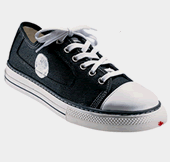Eco-friendly: Why green is the new black
MONDAY, APRIL 17, 2006
The jeans are funky, patched with color and highly decorated. But who could believe that this hip denim is having a second recycled fashion life and that the fabric is ecologically and environmentally sound?
When Earth Day reaches its 35th anniversary Saturday, it will have one small success to celebrate. The fashion industry, built on constant change and quick turnover, is taking a longer view. You no longer have to be an eco-warrior or a hippie to grasp the message. For the cool and stylish, green is the new black.
With Bono of U2 supporting his wife, Ali Hewson, in her Edun (read "nude" backward) venture and green Web sites sprouting like spring flowers, eco- awareness is becoming a hot topic and a growing business.
"Truly great design is coming through," said Bono about the fall/ winter collection. "We have got to find ways of making our activism sexy, and fashion is it."
"I place myself and this exhibition at the heart of the industry," says Rebecca Earley, a British designer of recycled and hand-dyed clothes and also the curator of a powerful show at London's Crafts Centre.
"Well Fashioned: Eco style in the UK" (until June 4) is interesting, informative and uplifting. It sends out a positive message rather than dwelling on fashion's destructive downside: clothing made from fabric with cheap labor, then dyed with pollutants, stitched in a sweatshop, washed frequently and ultimately dumped in a landfill.
"This is about good design, not products that shout 'eco' - and lots of designers don't want to create a green gang," says Earley, explaining her "long involvement" from fabric student in the 1990s at Central Saint Martins school, when she became aware that "everything I produced had a limited life span," to creating her own line and introducing her ideas to the academic world as a research fellow at Chelsea College of Art and Design.
The young talents in "Well Fashioned" include Terra Plana's recycled, quilted flowered boots, Howie's organic cotton T-shirts and recycled jeans from Red Mutha.
Earley has brought passion and dynamism to the Crafts Council, raising a flag for craft and design examined in a profound way. It tackles, in a series of explanatory labels and warnings ("257 gallons of water for one cotton T- shirt"), the three-pronged process that could make clothing eco-friendly: fair trade for low-cost fabric makers in the poorest countries such as in Africa, India and South America; sensitive care, by reducing washing temperatures to 30 degrees Celsius, or about 86 degrees Fahrenheit, and going easy on the water; and how to recycle clothes or even to learn to hang on to them.
"It is also about theory - engaging with people's deeper needs, their sense of belonging, of protection and their emotional attachment to clothing," says Earley, citing the designer Benjamin Shine's multifunctional clothes and her own collection, recycled from the wardrobe of a woman she knew.
The show starts with panels giving a brief history of British eco-awareness since wartime clothes rationing exhorted women to "make do and mend," to the flower children of the 1970s. Their flea market clothes have morphed today into vintage fashion on high-profile celebrities and clothes swapping on eBay.
There are samples of Duchy Originals, food and beauty products from the royal Highgrove estate, where Prince Charles first vowed to go green 20 years ago.
With more space, the show might have paid dues to Katharine Hamnett, the British designer who took up the fair trade cause at the end of the "greed-is-good" 1980s and has developed a pioneering fashion label based on ecology and the environment. Or it might have been widened to include the Danish designers, whom Earley describes as "so much more eco- aware." It cannot tackle the wide-ranging movement in America, or even Edun, founded in Dublin in 2005.
Earley's focus is on young independent designers, each with an ecological point of view and modern, rather than homespun, clothes. For example, a shinyAzo-free Ekotex jacket from Ciel by Sarah Ratty has an urban cool; and Enamore's clothes made of "cannabis Sativa," or hemp, are streamlined and stylish. If cotton is a favorite, with the Juste label working for fair trade in Africa, there are also fabric surprises. Emma Newberg, a graduate of the Royal College of Art, has produced flowery dresses with cape collars made from recycled plastic polyethylene vinyl acetate.
In fact, synthetic fabrics can be as eco-friendly as natural fiber, with polyester offering "positive benefits" from its low laundry demands. Earley has even discovered a technique of dyeing using paper blotters to create minimum effluents and less water waste.
How realistic is the idea of turning the fashion industry green? Earley admits that using low-impact dyes "is a craft technique; it can't translate into industry." She also believes that most designers do not even think about their fabrics and how and where they are made. But she says that, while everyone focuses on manufacturing, the industry needs "conceptual ways of thinking so that clothes function better when you get home."
Earley, working with other green groups, has already staged eco-shows in Paris and New York. The day that a big brand endorses eco-principles and makes it a selling point will be a prized moment for planet fashion - and planet Earth.







 style?
style?